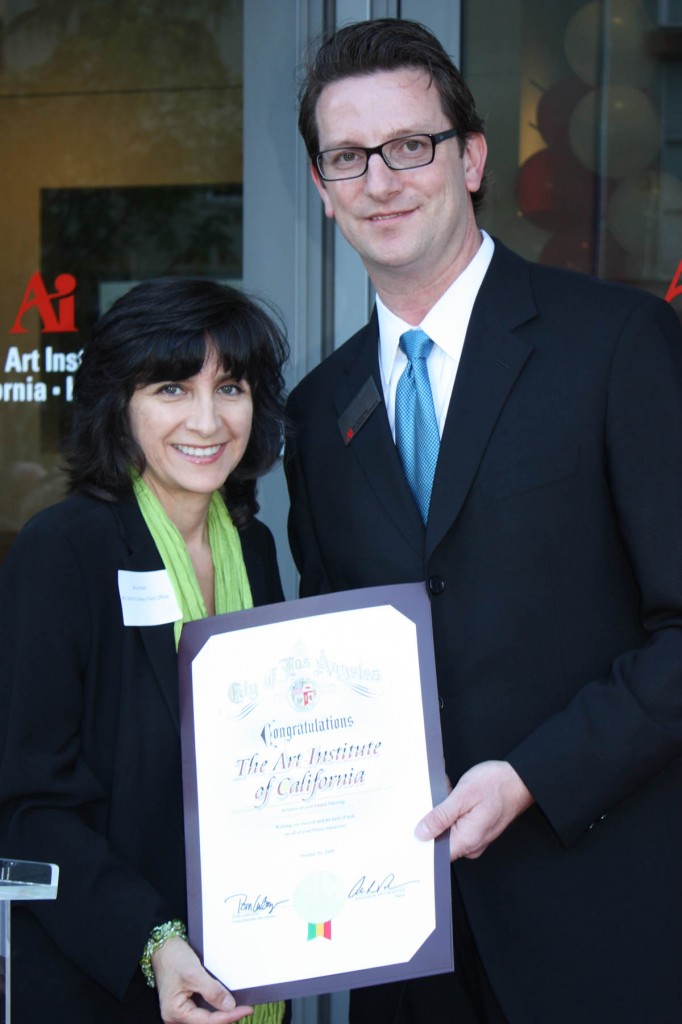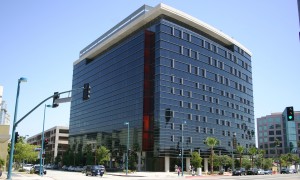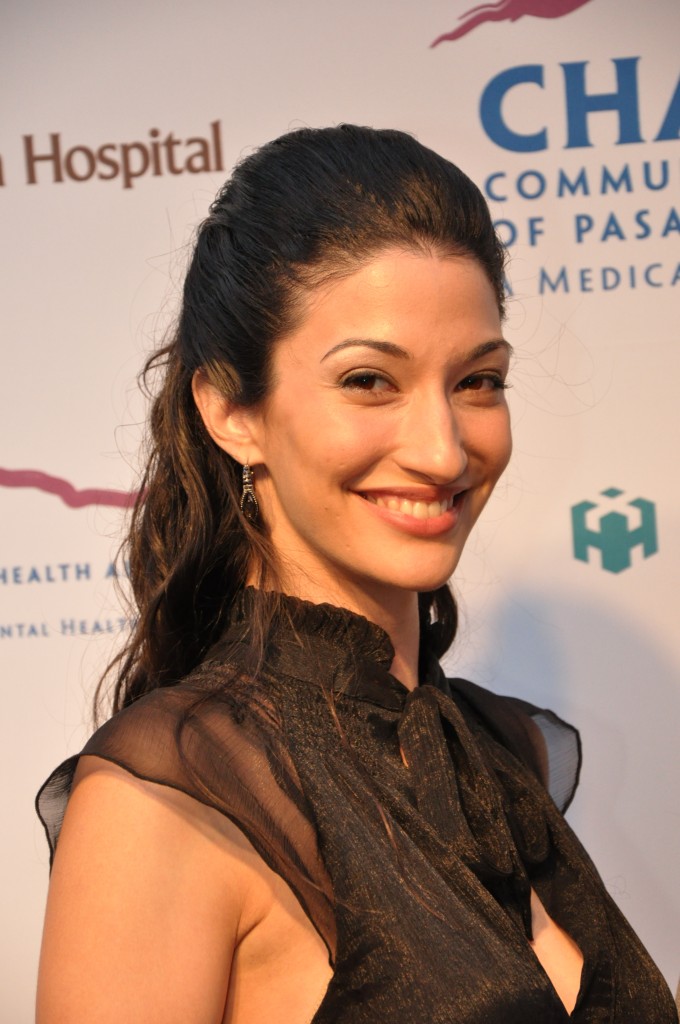Community News
Community News — By Buddy Sampson on May 23, 2010 at 1:50 pm
Alice Roth and Art Institute President Marick prepares to help student to compete in Creative Endeavors
The Art Institute of California, North Hollywood
The new facility has several floors of classrooms, labs and offices and it is an impressive structure indeed. We were given several demonstrations, including culinary instruction, digital lab studies and more.
Over 100 staff and faculty and several hundred students welcomed theNorth Hollywood neighborhood, city officials, and broader Art Institutes community on October 20, 2009 to join them in celebrating this new location. Speakers included The Art Institute of California – Hollywood President Gregory J. Marick, Jerry Snyder and Pat Irvine (JH Snyder Company ), student Ben Black, North Hollywood resident and entertainer Allee Willis, and Councilmember Tom LaBonge, all of whom arrived by Prius. Guests enjoyed live music, locally catered food, and tours of the school facilities. Program demonstrations educated visitors on the scope of design, media, culinary, and fashion work that students encounter while at The Art Institute of California – Hollywood.
About The Art Institute of California – Hollywood The Art Institute of California – Hollywood has a student population of 1,250 and is one of The Art Institutes (www.artinstitutes.edu), a system of over 40 education institutions located throughout North America, providing an important source of design, media arts, fashion and culinary arts professionals.
The Little Medical Clinic That Could
Community Health Alliance of Pasadena
(CHAP) has made inroads in healthcare for the local Pasadena community.
By Buddy Sampson
President Obama outlined one of his core missions for the U.S. and that was to provide affordable health care for all of its citizens. The health care industry has taken its hits in our current recessionary economy. Many Americans cannot afford health care and resort to small medical clinics, which have become a vital cog in regard to helping individuals and families for necessary health needs. A shining example of one of those organizations is the Community Health Alliance of Pasadena (CHAP), located on Fair Oaks Avenue in Pasadena.
Margie Martinez, CEO, CHAP is without a doubt, one of the busiest, conscientious and caring individuals you’ll ever meet. There’s a lot more to her, however, than meets the eye. Martinez and the staff of CHAP all have a gift-an innate sense that enables them to live and fulfill President Barack Obama’s dream -the ability of giving service to others; service to those that have fallen on tough times because of the state of the economy. They also have a keen eye for patient sensibilities. “We access what the community needs and then adjust what we do to accommodate the community,” said Margie Martinez.
CHAP, which originated in the early 90’s, was formed because residents in Pasadena were concerned about the lack of health care in the area. In 1993, the City of Pasadena purchased the former Pasadena Community Hospital, which had been vacant for many years. They incorporated as a non-profit organization in 1995 and opened in 1998. Martinez, who started at CHAP in 1999, remembers that time. It was a time of trials and tribulations. “It’s interesting, because I was the only employee of CHAP at that time,” she said. “The clinic had been open for a year but was under an operating agreement with Huntington Hospital. So I came in essentially to be the Executive Director, to raise money.” But about 6 months after she started, in June of 1999, Huntington Hospital informed CHAP that they no longer wanted to be its operating partner. “Since I had been hired by the Board of Directors and I had the experience, we decided to turn it into a community operation.”
However, the current economic period presents challenges. Consumers and patients have been adversely affected by high unemployment, a rise in home foreclosures, which have increased the homeless population and mounting health care expenses, which makes medical care to no income and low income patients a difficult prospect. CHAP has helped immensely, through its medical care to Pasadena and outlying residents, to combat that adversity. “Well, in some respects, we’ve always dealt with a population that’s uninsured,” Martinez explained, when asked about how CHAP has dealt with State and Federal budget cuts. “So we’ve always had to come up with other resources and supplement what we do, such as fundraising, approaching foundations and things like that.”
In the current economy, fundraising can be quite a daunting task, but Martinez feels up to the challenge. “So now we’re trying to refocus how we’re bringing in the revenues from the programs that have some kind of third party payment streams, like commercial insurance,” said Martinez. “But now that people are going to be out of work, it’s really going to throw more uninsured people back into our doors. So part of our challenge is to develop a fee structure that’s affordable and reasonable for people.” CHAP takes patients based on patient needs. They are more concerned with the health of its patients and less with their ability to pay. That presents a monumental challenge. Many of their patients haven’t had health insurance or health care, for that matter in many years, so they tend to be in poorer health than those that have had insurance. “Those health problems can be severe,” said Martinez. “Chronic diseases, like diabetes, hypertension- not being able to access good food or not being able to exercise can be devastating.”
On March 5, 2009, CHAP, through the American Recovery and Reinvestment Act, the stimulus package recently approved by the U.S., was awarded 1.3 million dollars to support its primary care operations. The grant will help CHAP’s operations, in conjunction with a community urgent care clinic in development at 3160 East Del Mar Blvd. CHAP was only one of seven Los Angeles County community clinics to receive an award in the initial round of funding. “The community effort that has gone into the planning of the primary care/urgent care center made a difference in the strength of CHAP’s proposal,” said Martinez. “Expanding access to health care will benefit local residents and businesses.” This grant will help to supply needed resources to further assist in CHAP’s mission to provide medical service to patients in need. Additionally, the grant will help in regard to upgrading electronic health records and patient information. “We are already on electronic health records, so this is the good thing about making better technology available,” she said.
There are many patients that are grateful to CHAP for providing medical care, care that they wouldn’t have received otherwise. CHAP services many in the minority community. Its patients are 66% Latino, 18% African-American, 2% Asian, 12% Caucasian and 2% others. “I don’t know what I would have done without services like CHAP,” said a homeless person who preferred to remain anonymous. “The services here far surpasses what I’ve had with previous employers,” said John Dionisio, who currently is unemployed. “The doctors here are excellent. I’m surprised and pleased. If you don’t have benefits, this is the place to go.” Maria, a Latina who depends heavily upon community medical care, recognizes the need for clinics like CHAP. “We need places like CHAP,” she said. “It’s difficult to find quality health care.” Cedric, an African-American man with diabetes, who is unemployed, sometimes takes five pills a day to treat his diabetic condition. “Places like CHAP are essential,” he explained. “You have to have it. When I’ve lost my job, where do you go? And health care is way too expensive. Even when you have health insurance, they don’t cover everything. If you know you have a chronic problem, these are the kind of places that need to exist.”
However, the stimulus grant is only a temporary fix. More assistance will be needed to fund projects in the future. Martinez feels optimistic about CHAP and the future of patient care. “I feel very good,” she said. “We had tons of trials and tribulations, but in the end, what it did was improve the quality of care for our patients and they deserve the best. We deserve the best and the community deserves the best. I think we’ll see the payoff down the line as the quality of care improves. We can really demonstrate that the outcome that patients are experiencing is due to the high quality of care that we provide.”
Indeed, with the growth of CHAP and the potential fulfillment of Barack Obama’s dream, CHAP has become the little medical clinic that could.





 Tweet This
Tweet This Digg This
Digg This Save to delicious
Save to delicious Stumble it
Stumble it





615 Comments
Hi. I just noticed that your blog sounds like there are a few code errors in the bottom of these site’s page. I am not sure if anyone is getting this same bugginess when looking in your web blog? I am using an entirely different browser than most people, known as Opera, so that is what may be causing it? I wanted to make sure you know. Many thanks for writing some of great postings as well as I will try to come back again with a different web browser to test things out.
I always was interested in this subject and still am, thankyou for posting .
I was extremely pleased to locate this webwebsite.I wanted to thank you with regard to this excellent read!! I certainly appreciated every little bit of it and I’ve you bookmarked to look at new things you publish.
Great! Thanks for post
heel erg fijn reeds
I added Google Reader to your site when I have spare time try to follow.
^^ yeh that is so true. I have to agree with you
Thankful i discovered , this website, Another good site is Buy Dianabolwill be sure to take a note of it so i can check-out regularly.
do you have an rss feed?
very informative post. Looking more to something like this
Sorry for the huge review, but I’m really loving the new Zune, and hope this, as well as the excellent reviews some other people have written, will help you decide if it’s the right choice for you.
I am thankful that I detected this web blog , just the right info that I was searching for! .
great blog but some pictures will make it better
omg…courtney cox is so gorgeous!
Cheers for this posting, guys, retain up the fantastic operate…